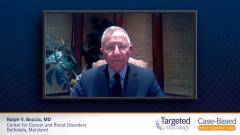
Frontline Therapy for mCSPC
Episodes in this series
Ralph V. Boccia, MD: When faced with a patient such as this, we must ask ourselves, “What would our treatment goals be?” Obviously, everyone thinks about survival, so 1 of our goals would be to prolong this man’s life as much as possible. Remember, this man already presents with symptoms from his bony metastatic disease, so another goal would obviously be to control his pain. We want to be able to offer him a therapy that’s tolerable, so we can provide him quality of life. Quality of life, control of symptoms, improvement in survival as best we can.
Our next step talking with this man is going to be what kind of therapy can we offer him. Any time we sit before a patient with any type of cancer, we want to be able to offer them options. The options as we describe them must be data based. We have to be able to offer them evidence-based results so they can help us choose what’s best for them. We take into consideration comorbidities, age, and variety of social factors. All those must come into play. But if you look just at the NCCN Guidelines for a patient such as this without taking into account those other peripheral issues, you see a number of things that are recommended.
In the not-too-distant past, for many years, single-agent monotherapy androgen deprivation therapy was considered the appropriate approach for a patient with castration-sensitive disease. What used to be category 1 is now deescalated to a category 2A, and the reason is we have alternative endocrine or targeted therapies that will improve progression-free and overall survival significantly.
Those would include the old therapies, such as abiraterone with androgen deprivation therapy. Let me give a caveat by saying that androgen deprivation therapy is still and always will be the cornerstone with which we continue to treat patients at all stages of the disease, whether they’re castration sensitive or castration resistant. We then add to that other potential agents to build on the efficacy, response rates, quality of life, and build on the survival. Androgen deprivation therapy is still considered an option for patients but no longer a category 1; it’s a category 2A.
Then we have 1 of the first drugs, abiraterone, that we can block. In fact, the conversion to testosterone in the adrenal glands and further improves the control of the cancers in combination with androgen deprivation therapy. That’s an old drug and has its own issues regard to other steroid therapies and requirement of steroid replacement therapies. We have newer drugs that are more targeted to the androgen receptor: enzalutamide, abiraterone, and apalutamide. We have those in combination with androgen deprivation therapy as options.
What you’ve got to do when you talk about androgen deprivation therapy plus androgen receptor–targeted therapy with either enzalutamide or apalutamide is the potential off-target toxicities or adverse events that these can cause. We have androgen deprivation therapy, androgen deprivation therapy plus abiraterone, androgen deprivation therapy plus apalutamide, androgen deprivation therapy plus even a taxane. Docetaxel, which we’ve used for many years in patients and became castration resistant before some of these targeting agents became available, is also considered to be a reasonable agent based on STAMPEDE and other trials, even in the frontline setting. That’s an option for patients. Clinical trials are always an option, and we have some other androgen-targeted therapies that we can use as well.
Transcript edited for clarity.
Case: A 66-Year-Old Male with Metastatic Castrate-Sensitive Prostate Cancer
Initial presentation
- A 66-year-old man presented with mild intermitted back pain
- PMH: DM; medically controlled; OTC analgesics for pain
- FH: No known family history of cancer
- PE: DRE revealed an enlarged prostate; otherwise unremarkable
Clinical Workup
- PSA 70 ng/mL
- Core needle biopsy with TRUS showed adenocarcinoma of prostate
- Gleason score (4+4)
- Bone scan revealed 4 spinal lesions (T8/T9, L1/L2) and 1 in the right femur
- Chest/abdominal/pelvic CT scan was negative for distant metastases
- Diagnosis: stage IV mCSPC
- ECOG PS 1
Treatment and Follow-Up
- He was started on ADT + apalutimide 240 mg qDay
- At 2-month follow up: PSA 10 ng/mL
- No new lesions on repeat imaging








































